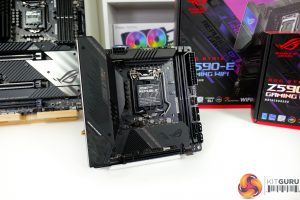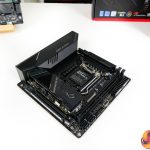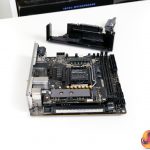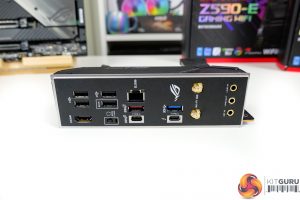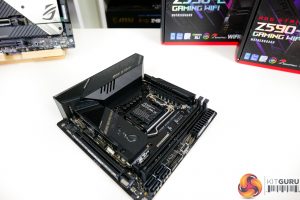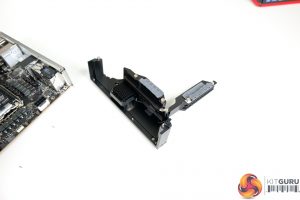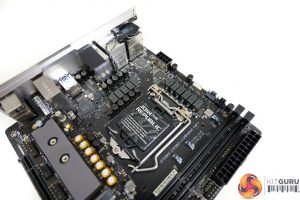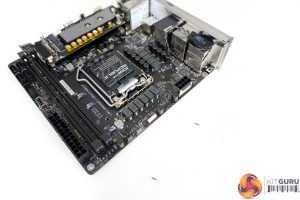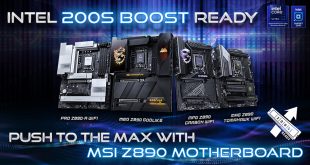The ROG STRIX Z590-I Gaming WiFi uses a largely black and grey styling that look good overall with no obnoxious features. ASUS minimises the use of large, overpowering components that can cause interference headaches, except the M.2 daughterboard.
Connectors come in the form of a single 8-pin for CPU power, 2 RGB headers, and 10Gbps internal USB-C and 5Gbps internal USB 3 headers. You also get three total fan headers but these are only rated at 12W/1A which a bit meagre for powering splitters from a motherboard of this cost. ASUS smartly includes break-out cables for dual USB 2.0 headers and front panel IO ports.
The primary expansion slot is a steel-reinforced PCIe x16 version. This will run at PCIe Gen 4 with an 11th Gen CPU and it can be bifurcated as x8/x4/x4 or x8/x8. That’s good if you want a high-speed storage mini server and are happy with the iGPU. Four outwards SATA connectors serve HDD and SSD duties.
ASUS' daughterboard provides a top M.2 slot and an underneath M.2 slot in a double-stacked design. This is arguably better than the one front and one rear approach of other ITX motherboards, as both M.2 SSDs are cooled by ASUS’ metal heat strips and thermal pads. I thought M.2 accessibility would be better, but this is not the case; it was easier for the VRM heatsink to be taken off in order to access the underneath SSD slot for my sample.
The top M.2 slot is PCIe Gen 4 x4 from the 11th Gen CPU. This only works with 11th Gen CPU and is completely unusable with a 10th Gen chip. Whilst very annoying and severely limiting for 10th Gen users, this is an Intel platform limitation so it is hard to criticise ASUS too much. The underside M.2 slot is PCIe Gen 3 x4 or SATA from the Z590 chipset and can be used with 11th Gen or 10th Gen CPUs.
ASUS' daughterboard holds the Realtek ALC4080-based audio system with Nichicon caps. But don't expect too much output capability here as you only get the three rear IO jacks alongside the internal header.
The rear IO is undeniably bare but it should suffice. Six USB Type-A ports are provided – 1x 10Gbps USB 3.2 Gen 2, 1x 5Gbps USB 3.2 Gen 1 (USB 3.0), and 4x old USB 2.0 ports including one which handles BIOS Flashback. This is too many old USB 2.0 ports and not enough of the newer, higher-speed versions such as 5Gbps USB 3.0 Type-A. ASUS, this is not a good USB design at all for a premium mITX motherboard.
20Gbps USB 3.2 Gen 2×2 Type-C is a great inclusion especially if you have a fast SSD to use it. And the Intel JHL8540-powered Thunderbolt 4 port is fantastic for the Mini-ITX ecosystem, especially as it supports 5V/3A 15W USB power delivery through a Cypress Semi chip.
Intel 2.5GbE and 2×2 WiFi 6E support are ideal for high-speed networking nuts, especially those with a fancy new router. And you get full-sized HDMI 2.0 and DP 1.4 through the TB4 Type-C port for 4K60 video outputs. No rear IO clear CMOS is annoying.
ASUS deploys a commendable heatsink design for the ITX motherboard. The heatsink is dense and reasonably heavy, the screw-down installation is high pressure and makes good contact between the thermal pads and VRM components, and you also get a heatpipe connecting both individual metal cooling blocks. Housed on the left-side heatsink-come-rear-IO-cover is a 30mm VRM fan. This has its own dedicated speed control header and pushes air through a small set of metal fins. Grills above the fan on the rear IO cover allow for airflow access.
The power delivery solution itself is a design with 11 total stages split as 8+2+1. A high-quality Intersil ISL69269 PWM controller manages the system without doublers. Texas Instruments 95410 power stages are used for the CPU VCore and these look to be rated at 90 Amps current output. So you get a theoretical 720 Amps peak output for the 8 stages driving the CPU, which looks to be perfectly adequate in general.
Four CPU VCore stages are to the left side and four are to the top side, so the VRM heatsink heatpipe makes perfect sense to balance the thermal load. The three remaining power stages are lower rated 70A Texas Instruments 59880 stages which are still very high-end. TR15-marked chokes and 5K-rated MIL capacitors round out the high-quality power delivery solution that looks to be well cooled.
 KitGuru KitGuru.net – Tech News | Hardware News | Hardware Reviews | IOS | Mobile | Gaming | Graphics Cards
KitGuru KitGuru.net – Tech News | Hardware News | Hardware Reviews | IOS | Mobile | Gaming | Graphics Cards



